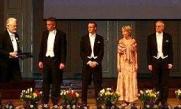Upper Cretaceous clay deposits of the Kristianstad area in southern Sweden have yielded plant microfossils of various kinds. I studied unicellular, acid-resistant microfossils from the locality Åsen (Näsum parish) and interpreted them as vegetative cells and resting cysts of algae. I described forms referred to the genus Tetraporina Naumova.
Several modern algal taxa include forms which are similar to Tetraporina with regard to the outer shape, surface ornamentation, and cell wall build up, so I did not refer Tetraporina to any modern algal taxon.
The impossibility in referring Tetraporina to a natural algal group is further accentuated by the fact that the development of modern unicellular algae, similar to those fossil forms, includes morphological changes which at least in part are due to environmentally controlled factors, such as nutrition and temperature. Tetraporina is thus a form genus of admittedly heterogeneous composition.
I emended the generic diagnosis of Tetraporina and described ten new species: Tetraporina denticulata, T. diagonalis, T. foveolata, T. mammillata, T. pulvinula, T. scanica, T. spinifera, T. verruculosa, T. vesiculata, and T. villandica.
References
Lindgren, S., 1980.- Algal microfossils of the form genus Tetraporina from Upper Cretaceous clays, southern Sweden. Review of Palaeobotany and Palynology, 30: 333—359. Amsterdam. ISSN 0034-6667.
- Lindgren, S., 1987.
- Modern algae resembling fossil Tetraporina. (Abstract in Hindi.) The Palaeobotanist, 35 (2): 131—135. Lucknow. ISSN 0031-0174.










